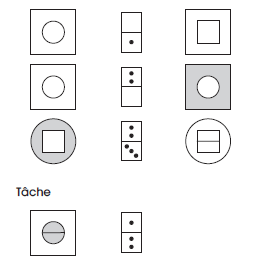Govjobs had temporarily introduced a new type of abstract reasoning in its sample tests. They are diagram series, close to the ones present in the EU public service competitions.
In these tests, each question consists of a series of diagrams containing geometric shapes that are repeated or modified according to a logic sequence. Candidates must identify the underlying logic and find the diagram that completes the series from 5 possible options.
Example
From the five options A, B, C, D and E, choose the diagram that completes the upper series.

Let’s take it one step at a time
The abstract reasoning test is a visual test. You must look at the shapes contained in the diagrams and visualise the logic sequence. This can be done in two ways: analytically or globally.
The anarecommended for those who are not (yet) accustomed to abstract reasoning. If you “see” nothing, this is the method for you! It’s a very gradual process. Are you ready?
Let’s begin. First, what do we see in the upper diagrams? Two shapes: a square and a triangle. Let’s choose one of them, for example, the square. If you prefer the triangle, no problem – it will work too!
Let’s go back to the square. We can see that it changes colour according to the following sequence (yes, you can recite it!): black, black, black, white, white, so … white again. The answer diagram must therefore contain a white square. This means we can eliminate options B and E.
Let’s continue with the square. We can also see that it changes size according to the following sequence: small, large, large, small, large, so … large again. The answer diagram must therefore contain a large square. So we can eliminate option D. The correct answer is therefore either A or C.
Let’s look at what differentiates diagrams A and C. It’s the position of the triangle. In diagram A it’s on the left and in diagram C it’s on the right. In order to find the correct diagram, we must therefore determine the sequence associated with the position of the triangle: left, right, right, left, right, so … right again. The correct answer is therefore C.
The analytical approach is really quite fun. Finding the visual sequence is a question of rhythm. Feel free to recite it (though not necessarily aloud!). The next in the sequence will come automatically.
Let’s broaden our vision
There are those who can’t get it … and then there are those who get it straight away (they’re really annoying for the first group). But don’t worry, with a bit of training you’ll soon find yourself in the second group, if you’re not already there.
People who see the sequence straight away use a global approach. They don’t focus on any particular element of a diagram but look at the diagrams as a whole. They identify the analogies.
In the example above, they will immediately establish an analogy between diagrams 1, 2 and 3 on the one hand, and diagrams 4, 5 and therefore … the answer diagram on the other. This is how they see the series:

Let’s put ourselves in their place for a moment. We can see by analogy that, in the answer diagram, there must be a white triangle at the top right and a large white square at the bottom left. This configuration matches diagram C.
In conclusion
The abstract reasoning test calls upon us to use skills that we are not accustomed to using in our everyday life: the ability to visualise geometric transformations (rotations, symmetries, etc.), the aptitude to identify analogies between complex shapes, etc. But each of us is capable of developing these skills. It’s not a question of intelligence but of learning. So, what are you waiting for?
ORSEU Competitions provides this book, these online course and online tests that will enable you to become a pro at abstract reasoning too!









